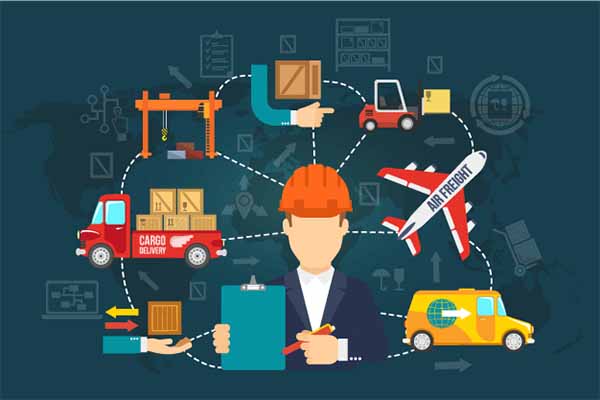The economy of India is growing at a faster pace, despite facing headwinds from geopolitical situations. It has implemented several growth-oriented reforms to keep the economy on track and has created an ecosystem for all industries to thrive. Among these industries, the logistics sector is the one that has been connecting the country through its fast-paced deliveries, robust operations, and impeccable fleet management. It accounts for about 14.4 % of the total GDP and employs more than 22 million people in India, according to IBEF. This tremendous growth has been the result of the rapid adoption of new-fangled technology.
Technology in logistics
Due to contemporary business practises and developments, the flow of goods from producers, merchants, or wholesalers to final consumers has changed. The logistics industry has also been significantly impacted by the switch from manual to automatic technologies as well as developments in communication and information technology. With this growth, India is the seventh-largest market for logistics companies, according to the World Bank. Furthermore, logistics companies in the country are currently valued at $200 billion, and by 2025, they are expected to grow at a rate of 15% annually to reach $380 billion.
Let us now delve into what the advent of technology has changed in the logistics sector.
Customer expectations have changed
Customers of the digital age expect to receive their deliveries quickly and on time, and they want to have real-time visibility of their packages. This demand arose due to the internet and smartphone penetration, which also resulted in pressuring the logistics enterprises to cater to the customer’s bulging needs. In order to maintain efficiency, improve customer satisfaction and retention, improve supply chain management, and simplify numerous other applications, technology was put to use in this way.
Rapid use of IoT (Internet of Things)
The Internet of Things (IoT) has revolutionised several industries with its use cases and is now being readily used in the logistics sector as well. IoT devices can be used to track the location and temperature of objects. Additionally, companies can equip their trucks with sensors to monitor their location. The state of the products and how well they have been handled may also be monitored using IoT. This can help logistics businesses manage inventory levels and streamline their operations. Significant cost savings, improved efficiency, improved customer service, and even quicker decision-making were all outcomes of IoT use.
Surge in digitalisation
The logistics sector has undergone a major revolution thanks to digital technology. Businesses can now use digitalization to adapt their current procedures, take on new initiatives, and even redesign their customer experiences in order to meet changing customer demands and dynamic business situations. Modern digital technology is assisting several logistics businesses in increasing productivity, centralising their operations, and performing preventative maintenance on their vehicles. Furthermore, logistics companies are embracing GPS services, barcodes, FastTags, and e-way bills to streamline their operations and save time, money, and effort. To digitise their supply chain, many businesses are adopting cloud-based software, block chain, big data, and many other technologies. Digitalization in the logistics industry is not a substitute but has become a necessity.
Automation for repetitive tasks
Automation is quickly moving to the top of logistics companies’ agendas due to a number of trends. This is because of factors like a growing labour shortage, a surge in demand from online retailers, and some intriguing technological developments. One such development is logistics automation, which can refer to both hardware and software. Automated storage and retrieval systems (AS/RS), robotic arms, and drones are frequently used devices to support logistics operations. Additionally, this technology encompasses forecasting models, digital CRM software, and e-commerce platforms. As more contemporary logistics setups automate their operations, automation is becoming more widespread.
Rise of digital payments
Companies are embracing digital payments in order to benefit from fresh possibilities that enable them to further streamline their supply chains. MeitY (The Ministry of Electronics and Information Technology) reported a 33% increase in digital transactions to 7,422 crore in financial year 2022. By switching to digital payments and workflow, businesses can expedite daily operations, reduce employee workloads, and make sure that every crucial detail is taken into account along the entire supply chain. It reduces the possibility of human error by doing away with paper invoices, manual data entry, and keeping old records. The experience of making a payment on both ends of a transaction is greatly enhanced by digitising the tracking, invoicing, and collection of funds.
All things considered
The changes in the logistics sector came as a result of technological advancements. India’s logistics companies faced challenges in reducing delivery times while also dealing with increased orders and changing customer expectations. Therefore, they had no option but to embrace the advent of technology and utilise it as per the requirements of the markets. The supply chain’s productivity has increased thanks to technology, which has also decreased costs and errors. The logistics industries as a whole have greatly benefited from new-age technology, which is providing enormous benefits to the logistics sector, which will expand as new developments are made. For many years to come, technological advancements will keep enhancing the landscape of the logistics industry.
About the author:

Arshdeep Singh Mundi is Managing Director at Jujhar Logistics.















